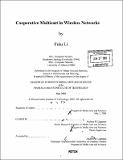| dc.contributor.advisor | Andrew B. Lippman. | en_US |
| dc.contributor.author | Li, Fulu, 1970- | en_US |
| dc.contributor.other | Massachusetts Institute of Technology. Dept. of Architecture. Program In Media Arts and Sciences | en_US |
| dc.date.accessioned | 2006-03-29T18:51:00Z | |
| dc.date.available | 2006-03-29T18:51:00Z | |
| dc.date.copyright | 2005 | en_US |
| dc.date.issued | 2005 | en_US |
| dc.identifier.uri | http://hdl.handle.net/1721.1/32507 | |
| dc.description | Thesis (S.M.)--Massachusetts Institute of Technology, School of Architecture and Planning, Program in Media Arts and Sciences, 2005. | en_US |
| dc.description | Includes bibliographical references (p. 102-106). | en_US |
| dc.description.abstract | Wireless communication has fundamental impairments due to multi-path fading, attenuation, reflections, obstructions, and noise. More importantly, it has historically been designed to mimic a physical wire; in concept other communicators in the same region are viewed as crossed wires. Many systems overcome these limitations by either speaking more loudly, or subdividing the space to mimic the effect of a separate wire between each pair. This thesis will construct and test the value of a cooperative system where the routing and transmission are done together by using several of the radios in the space to help, rather than interfere. The novel element is wireless, cooperative multicast that could be the basis for a new broadcast distribution paradigm. In the first part of the thesis,. we investigate efficient ways to construct multicast trees by exploring cooperation among local radio nodes to increase throughput and conserve energy (or battery power), whereby we assume single transmitting node is engaged in a one-to-one or one-to-many transmission. In the second part of the thesis, we further investigate transmit diversity in the general context of cooperative routing, whereby multiple nodes are allowed for cooperative transmissions. Essentially, the techniques presented in the second part of the thesis can be further incorporated in the construction of multicast trees presented in the first part. | en_US |
| dc.description.statementofresponsibility | by Fulu Li. | en_US |
| dc.format.extent | 106 p. | en_US |
| dc.format.extent | 4170553 bytes | |
| dc.format.extent | 4176379 bytes | |
| dc.format.mimetype | application/pdf | |
| dc.format.mimetype | application/pdf | |
| dc.language.iso | eng | en_US |
| dc.publisher | Massachusetts Institute of Technology | en_US |
| dc.rights | M.I.T. theses are protected by copyright. They may be viewed from this source for any purpose, but reproduction or distribution in any format is prohibited without written permission. See provided URL for inquiries about permission. | en_US |
| dc.rights.uri | http://dspace.mit.edu/handle/1721.1/7582 | |
| dc.subject | Architecture. Program In Media Arts and Sciences | en_US |
| dc.title | Cooperative multicast in wireless networks | en_US |
| dc.type | Thesis | en_US |
| dc.description.degree | S.M. | en_US |
| dc.contributor.department | Program in Media Arts and Sciences (Massachusetts Institute of Technology) | |
| dc.identifier.oclc | 61922406 | en_US |
